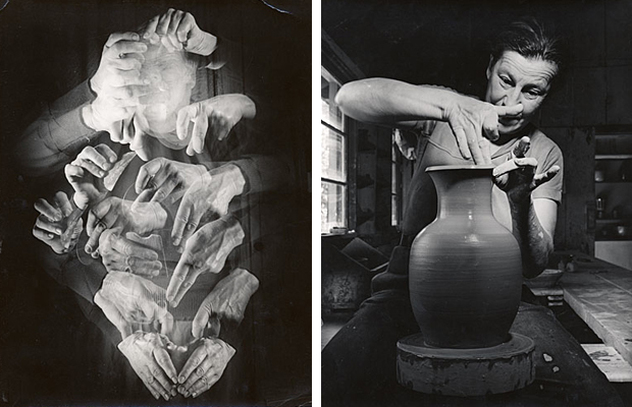The Bauhaus’s ceramics workshop started out in Dornburg at the workshop of the master potter Max Krehan. Here, ceramic vessels, some of them experimental, were made in collaboration with the sculptor and master of form, Gerhard Marcks. In 1923, the pottery workshop made a technological leap by moving from the potter’s wheel to ceramic casting. This is also where prototypes for serial production were made. The ceramics workshop was not continued in Dessau.
As one of the first workshops at the Bauhaus, the ceramics workshop was opened as early as 1919 at a Weimar furnace factory. In 1920, the workshop moved to Dornburg, Saale. This was just 20 kilometres away and offered enough space for student accommodation as well as the workshop. Until 1925, Gerhard Marcks was head of the workshop. The renowned master potter Max Krehan was the master of works from 1920 to 1925.
Initially, the workshop only produced simple ceramics for everyday use with the plain glazes typical of the Bauhaus. Due to Walter Gropius’ orientation towards technology and the new goal of creating models for industrial mass production, the workshop was divided into an apprentice workshop for training and an experimental and production workshop. Prototypes for industrial production included Theodor Bogler‘s Mocha Machine, which was made using a casting process, and his combination teapot, which was based on the modular design principle. The workshop maintained contacts with several earthenware and porcelain factories, presenting its products at trade fairs and at the Stuttgart exhibition of the Werkbund (German Work Federation) of 1924.
The ceramics workshop did not survive the move to the Bauhaus Dessau. Otto Lindig, the former head of the production workshop, continued a part of the ceramics workshop at the Staatliche Bauhochschule (state school for architecture) in Weimar. - http://bauhaus-online.de/en/atlas/das-bauhaus/werkstaetten/keramikwerkstatt
As one of the first workshops at the Bauhaus, the ceramics workshop was opened as early as 1919 at a Weimar furnace factory. In 1920, the workshop moved to Dornburg, Saale. This was just 20 kilometres away and offered enough space for student accommodation as well as the workshop. Until 1925, Gerhard Marcks was head of the workshop. The renowned master potter Max Krehan was the master of works from 1920 to 1925.
Initially, the workshop only produced simple ceramics for everyday use with the plain glazes typical of the Bauhaus. Due to Walter Gropius’ orientation towards technology and the new goal of creating models for industrial mass production, the workshop was divided into an apprentice workshop for training and an experimental and production workshop. Prototypes for industrial production included Theodor Bogler‘s Mocha Machine, which was made using a casting process, and his combination teapot, which was based on the modular design principle. The workshop maintained contacts with several earthenware and porcelain factories, presenting its products at trade fairs and at the Stuttgart exhibition of the Werkbund (German Work Federation) of 1924.
The ceramics workshop did not survive the move to the Bauhaus Dessau. Otto Lindig, the former head of the production workshop, continued a part of the ceramics workshop at the Staatliche Bauhochschule (state school for architecture) in Weimar. - http://bauhaus-online.de/en/atlas/das-bauhaus/werkstaetten/keramikwerkstatt
